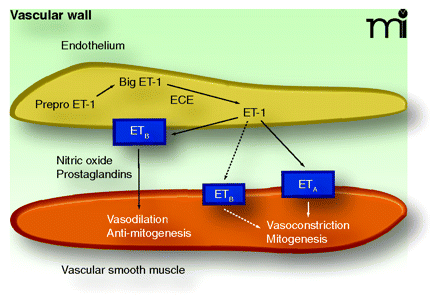
- Institution: Stanford Univ Med Ctr Lane Med Lib/Periodical Dept/Rm L109
- Sign In as Member / Individual
Does Targeting the Lipophilic Milieu Provide Advantages for an Endothelin Antagonist?

Fundamental mechanisms of ET-1 synthesis and receptor-specific actions in the vascular wall. Endothelin-1 (ET-1) synthesis begins with the initial gene product Prepro-ET-1 and is processed by series of proteolytic cleavages to form the immediate precursor, Big ET-1. Big ET-1 is cleaved by ECE to become ET-1. Big ET-1 is stored and released along with the more potent peptide, ET-1. ET-1, in turn, acts in an autocrine fashion to activate ETB receptors in endothelial cells to release vasorelaxing factors such as nitric oxide and prostaglandins. These factors have well-characterized actions to produce vasorelaxation and inhibit growth and proliferation of vascular smooth muscle. On vascular smooth muscle, the primary target is ETA receptors, which produce vasoconstriction along with mitogenic effects. In some vascular beds and in some pathological conditions, ETB receptors on vascular smooth muscle mimic the actions of the ETA receptor. However, little is known about the conditions in which these receptors are physiologically or pathophysiologically significant. ECE, endothelin–converting enzyme.


